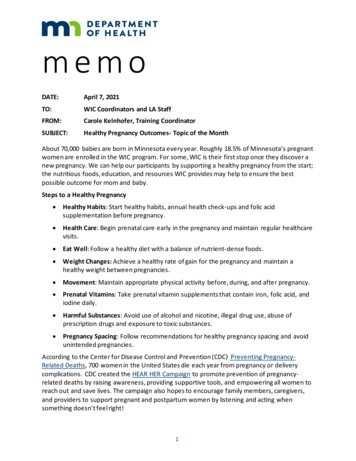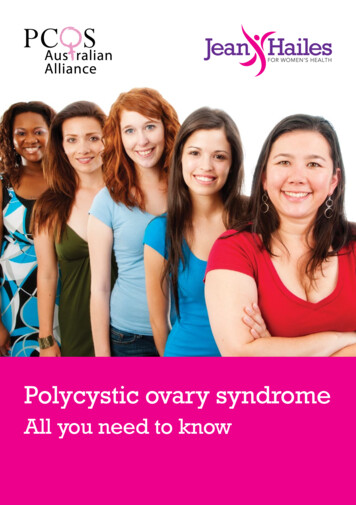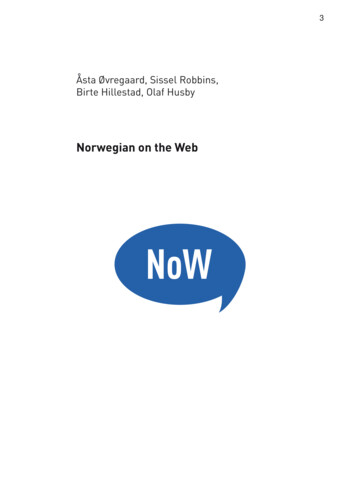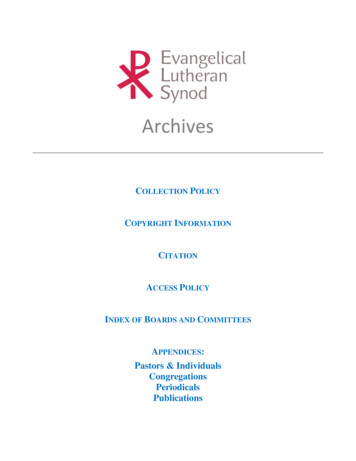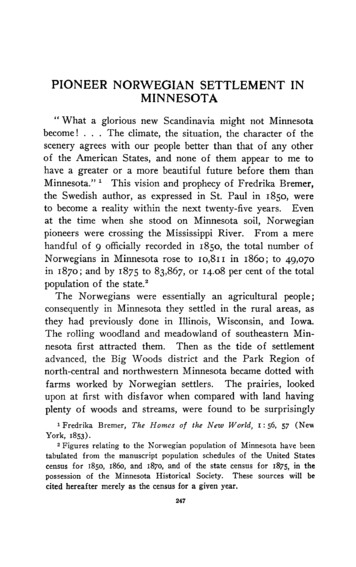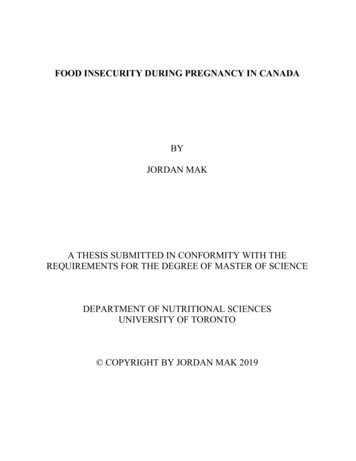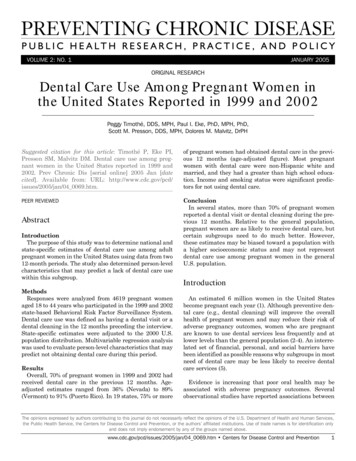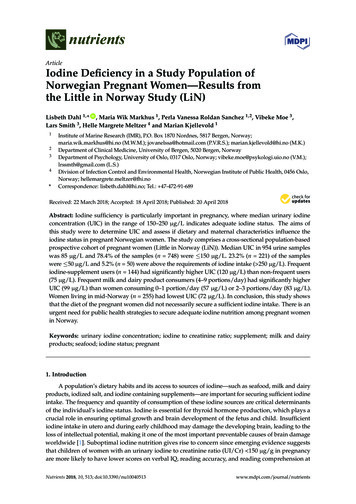
Transcription
nutrientsArticleIodine Deficiency in a Study Population ofNorwegian Pregnant Women—Results fromthe Little in Norway Study (LiN)Lisbeth Dahl 1, * ID , Maria Wik Markhus 1 , Perla Vanessa Roldan Sanchez 1,2 , Vibeke Moe 3 ,Lars Smith 3 , Helle Margrete Meltzer 4 and Marian Kjellevold 11234*Institute of Marine Research (IMR), P.O. Box 1870 Nordnes, 5817 Bergen, Norway;maria.wik.markhus@hi.no (M.W.M.); jovanelssa@hotmail.com (P.V.R.S.); marian.kjellevold@hi.no (M.K.)Department of Clinical Medicine, University of Bergen, 5020 Bergen, NorwayDepartment of Psychology, University of Oslo, 0317 Oslo, Norway; vibeke.moe@psykologi.uio.no (V.M.);lrssmth@gmail.com (L.S.)Division of Infection Control and Environmental Health, Norwegian Institute of Public Health, 0456 Oslo,Norway; hellemargrete.meltzer@fhi.noCorrespondence: lisbeth.dahl@hi.no; Tel.: 47-472-91-689Received: 22 March 2018; Accepted: 18 April 2018; Published: 20 April 2018 Abstract: Iodine sufficiency is particularly important in pregnancy, where median urinary iodineconcentration (UIC) in the range of 150–250 µg/L indicates adequate iodine status. The aims ofthis study were to determine UIC and assess if dietary and maternal characteristics influence theiodine status in pregnant Norwegian women. The study comprises a cross-sectional population-basedprospective cohort of pregnant women (Little in Norway (LiN)). Median UIC in 954 urine sampleswas 85 µg/L and 78.4% of the samples (n 748) were 150 µg/L. 23.2% (n 221) of the sampleswere 50 µg/L and 5.2% (n 50) were above the requirements of iodine intake ( 250 µg/L). Frequentiodine-supplement users (n 144) had significantly higher UIC (120 µg/L) than non-frequent users(75 µg/L). Frequent milk and dairy product consumers (4–9 portions/day) had significantly higherUIC (99 µg/L) than women consuming 0–1 portion/day (57 µg/L) or 2–3 portions/day (83 µg/L).Women living in mid-Norway (n 255) had lowest UIC (72 µg/L). In conclusion, this study showsthat the diet of the pregnant women did not necessarily secure a sufficient iodine intake. There is anurgent need for public health strategies to secure adequate iodine nutrition among pregnant womenin Norway.Keywords: urinary iodine concentration; iodine to creatinine ratio; supplement; milk and dairyproducts; seafood; iodine status; pregnant1. IntroductionA population’s dietary habits and its access to sources of iodine—such as seafood, milk and dairyproducts, iodized salt, and iodine containing supplements—are important for securing sufficient iodineintake. The frequency and quantity of consumption of these iodine sources are critical determinantsof the individual’s iodine status. Iodine is essential for thyroid hormone production, which plays acrucial role in ensuring optimal growth and brain development of the fetus and child. Insufficientiodine intake in utero and during early childhood may damage the developing brain, leading to theloss of intellectual potential, making it one of the most important preventable causes of brain damageworldwide [1]. Suboptimal iodine nutrition gives rise to concern since emerging evidence suggeststhat children of women with an urinary iodine to creatinine ratio (UI/Cr) 150 µg/g in pregnancyare more likely to have lower scores on verbal IQ, reading accuracy, and reading comprehension atNutrients 2018, 10, 513; ts
Nutrients 2018, 10, 5132 of 14eight years of age [2]. Results from the follow-up of the gestational iodine cohort (9-year and 15-year)in Australia indicate that even mild iodine deficiency during pregnancy may have consequences forthe child that are not improved by sufficient iodine intake during childhood [3,4]. Adequate maternaliodine status is therefore especially important since the fetus is dependent on maternal transfer ofthyroid hormones in early gestation and supply of iodine later in gestation. The recommended intakeof iodine during pregnancy is 175 µg/day in the Nordic countries [5] and 250 µg/day according toWorld Health Organization (WHO) [6].The urinary iodine concentration (UIC) captures the total iodine intake and is regarded as areliable biomarker for assessing recent iodine intake at a group level [7]. A median UIC in the range of150–250 µg/L indicates adequate iodine nutrition in a population of pregnant women [8]. By usinga median cutoff of 150 µg/L, insufficient iodine status has been demonstrated in pregnant womenin several European countries during recent years [2,9–12]. The population in Norway has longbeen considered iodine sufficient due to the contribution of iodine from milk and dairy products.The Norwegian Mother and Child Cohort Study (MoBa), including more than 80 thousand pregnantwomen, has challenged this assumption as a large proportion of these women was at risk of suboptimaldietary iodine intake [13]. Studies assessing UIC from pregnant women in Norway confirm the findingsof insufficient dietary iodine intake [13–15]. Further, the MoBa study has shown that an estimateddietary iodine intake 160 µg/day during pregnancy was associated with symptoms of child languagedelay, behavior problems, and reduced fine motor skills at age three years [16].Both season of the year and time point of urine sampling have been shown to influence theUIC [17,18]. Studies also suggest that gestational week is of importance for the interpretation ofUIC in pregnancy [19,20]. With urine samples and dietary data from approximately one thousandpregnant women, we aim to investigate their iodine status by measuring UIC and assess if maternalcharacteristics and dietary factors may influence the iodine status. Further, we ask if gestational week,time of urine sampling, season of the year, and creatinine levels may influence the interpretation ofiodine nutrition in pregnancy.2. Materials and Methods2.1. Study Population and DesignThis study used samples and data collected as part of a population-based prospective cohortdesigned to investigate pre- and postnatal risk factors influencing developmental malleability frompregnancy to 18 months of age. Families were recruited from nine different public health clinicsacross Norway. The clinics were chosen after considering demographic characteristics and size ofthe population to include participants from both cities and rural districts with a wide distribution ofsocioeconomic conditions. At each site, one midwife was trained as a research assistant and invited allthe pregnant women at 16–26 weeks gestation to participate, but some women were enrolled beforeweek 16 and some as late as week 30. Between September 2011 and mid-October 2012, 1041 familieswere enrolled. Five families withdrew their consent, leaving us with 1036 mothers. Three familieswere excluded due to stillbirth, and 26 were excluded for other reasons before birth of the child(i.e., poor parental health, family moving out of the area, participation felt to be too time consuming).These families let us keep the data we had already collected. We were left with 1007 mothers whogave birth to 1017 children (including 10 twin pairs; multiple pregnancies other than twins have beenexcluded). Figure 1 shows participation flowchart.Data collection phases comprised five points in pregnancy, birth, and four follow-up points upto age 18 months. Data collection up to 18 months was finished by November 2014. In this articleurine samples, dietary data, and demographic data from the pregnant women are used. The study wasconducted according to the guidelines in the Declaration of Helsinki and was approved by RegionalCommittees for Medical and Health Research Ethics in Norway (REK 2011/560). Written informedconsent was obtained from all subjects.
Nutrients 2018, 10, 5133 of 142.2. Data Collection and Categorization of VariablesA non-fasting urine sample was obtained from every pregnant woman in specimens collected ateach site. Gestational week, time of the day, and date of urine sample were registered. Since womenwere enrolled in the study at different gestational weeks, the spot urine sample was categorizedinto first (0–13 weeks of gestation), second (14–27 weeks of gestation), and third (28–40 weeks ofgestation) trimester. The time of day for sampling of the urine was categorized into morning (6–9 a.m.),noon (10–13 a.m.), afternoon (14–17 p.m.), evening (18–24 p.m.), and night (0–5 p.m.). The dateof sampling was divided into four seasons; spring (March–May), summer (June–August), autumn(September–November), and winter (December–February).A comprehensive questionnaire package was given to mothers and fathers at the first meeting afterinclusion, which could take place from pregnancy week 16 to 34, depending on the specific time ofenrollment. All parents were asked to answer these questions, irrespective of exact time of inclusion.Among the many questions, data on maternal (and family) characteristics such as age, weight beforepregnancy, height, parity, education, socio-economic status, and use of tobacco were obtained. Age ofparticipating women was divided in four categories; 25 years, 25–29 years, 30–34 years, and 35 years.The residence of the women was divided into north, mid, west, and east regions of Norway. The northarea included women from one sampling site (Tromsø), mid from three samplings sites (Trondheim),west (Bergen) from two sampling sites, and the east area of Norway included three different samplingsites (Oslo). Parental education was categorized into primary and high school (low), University Collegeor University 4 years (middle), or University College or University 4 years (high). The income of themother was categorized as 300,000 NOK, 300,000–449,000 NOK, and 450,000 NOK.Dietary data were collected using a web-based semi–quantitative food frequency questionnaire(FFQ) covering the last three months intake of iodine rich foods, such as seafood, milk, dairy products,and eggs in addition to some questions about the intake of other main food groups, such as fruitand vegetables, bread and cereals, and meat and meat products [21,22]. The first question regardingmilk and dairy products asked if they consumed milk and dairy products daily or weekly (‘yes’ or‘no’). A second question concerned portions of milk and dairy products intake per day, which wascategorized as 0–1 portions/day, 2–3 portions/day, and 4–9 portions/day. As to the first question,the non-daily users were included in the category 0–1 portions/day. The seafood intake was recodedto estimate the weekly intake for dinner and the daily intake of seafood as bread spread. Follow-upquestions regarding type of seafood were asked to differentiate between lean fish, fatty fish, and thefrequency of use of processed fish products (i.e., fish cakes, fish fingers, etc.). The weekly intake ofseafood for dinner was then dichotomized into 2 portions/week and 2 portions/week. Severalquestions regarding the use of supplements were asked, answers were divided into non-iodinecontaining supplement and iodine containing supplement based on information given in severalquestions. Supplement use was then dichotomized as users ( 5 times/week) and non-users( 5 times/week). The level of iodine in supplements on the Norwegian marked varies from 50to 225 µg. The maximum level to be added is set to 225 µg iodine per daily dose.2.3. Laboratory AnalysisThe spot urine samples were stored at minus 20 C approximately one month at each samplingsite before all samples were shipped to Institute of Marine Research (IMR) and stored at minus 20 Cuntil analysis of iodine and creatinine concentrations was carried out. Prior to analysis, the urinesamples were defrosted in a refrigerator. For the determination of iodine, 500 µL urine was diluted in4.5 mL 1% tetrametylammonium hydroxide (TMAH) and filtered using a sterile membrane filter witha 0.45 µm pore size and a single use syringe. Samples were analyzed against a urine calibration curve(standard addition curve) to measure the unknown iodine concentration (127 I) in the collected urinesamples. The accuracy of the results was verified with certified reference material; Seronorm TraceElements Urine (Nycomed Pharma, Asker, Norway) with certified iodine content of 84 µg/L (range
Nutrients 2018, 10, 5134 of 1472–96 µg/L) and 304 µg/L (range 260–348 µg/L). UIC was determined by inductively coupled plasmamass-spectrometry (ICP-MS).For the urinary creatinine determination, the urine samples were defrosted at room temperatureand centrifuged in an Eppendorf (5810R) centrifuge (15 min, 2000 g and 4 C). An aliquot of 200 µLwas transferred to the test tube and placed in the Maxmat carousel. All sample treatment was automatic;samples were diluted 1:20 with distilled water and reagents added. Determination of creatinine wasperformed by a colorimetric enzymatic principle using a MAXMAT PL II multidisciplinary diagnosticplatform using the Creatinine PAP kit, (ERBA Diagnostics, Montpellier, France). The method wascalibrated with one standard and further controlled with two independent controls.Creatinine concentration was also used to determine whether the spot urinary sample was valid.We have excluded urine samples with creatinine concentration outside the WHO guidelines of 0.3 g/Land 3.0 g/L [23].2.4. StatisticsWe report iodine status in two ways; as the urinary iodine concentration (µg/L) and as the urinaryiodine per gram creatinine (µg/g). Both measures were used to explore relations with participants’characteristics and dietary intake by using independent samples Mann–Whitney U Test. Medians and25th and 75th percentiles are reported for all these variables (Table 1). The 24-h excretion of iodine(UIE) was estimated by multiplying the iodine-to creatinine ratio by the expected daily excretion ofcreatinine 1.23 [24]. Spearman’s correlations were calculated for UIC, maternal characteristics andintake of iodine rich foods. Variables that showed a relation with the UIC and iodine to creatinine ratioin the unadjusted analysis (Table 1) were entered in the linear regression model to evaluate associationsbetween maternal characteristics or dietary factors (Tables 2 and 3). The relationship between UICor IU/Cr ratio was explored by linear regression, and we used a standard multiple regression model.Two-tailed p-values 0.05 were considered statistically significant. The statistical software packageStatistical Package for the Social Sciences (SPSS Statistics Version 24) was used for all data analyses.Table 1. Urinary iodine concentration (µg/L (UIC)) and urinary iodine to creatinine ratio (µg iodine/gcreatinine (UI/Cr ratio)) according to maternal demographic and behavioral characteristics given asmedian with 25th and 75th percentiles in the study population.n1UIC (µg/L)Maternal age, years 2525–2930–34 3593711434830517080 (53–143)85 (50–130)83 (54–120)88 (51–160)Smoking (daily) while pregnantNoYes9548827285 (57–140)70 (44–120)Parity01 295454733712078 (44–130)82 (52–135)80 (43–130)Educational levelPrimary 1 /high schoolCollege/University 4 yearCollege/University 4 year95423136041378 (48–130)85 (47–140)78 (47–130)CohabitationLiving with partnerNot living with partner9549124279 (47–130)85 (47–130)EthnicityNorwegianOther than Norwegian9549455978 (47–130)92 (56–140)Income (mother) 300,000 NOK300,000–449,000 NOK 450,000 NOK95432045323178 (45–130)80 (47–130)79 (50–140)p-Value *UI/Cr Ratio (µg/g)0.429p-Value *0.10071 (46–124)79 (49–122)86 (59–121)86 (54–139)0.1280.01983 (54–125)64 (45–107)0.8460.03490 a (55–138)80 a,b (52–119)75 b (45–118)0.217 0.000173 a (45–121)82 a,b (53–123)90 b (59–134)0.6320.84483 (53–127)83 (50–139)0.1260.22982 (53–127)90 (59–121)0.3310.00782 a (50–124)80 a (51–126)94 b (60–138)31 participants have completed primary school. Different letters indicate statistical differences. * p-value fordifferences between groups using Mann-Whitney U to compare two groups or Kruskall–Wallis test comparingcategories with more than two groups.
Nutrients 2018, 10, 5135 of 14Table 2. Urinary iodine concentration (µg/L (UIC)) and urinary iodine to creatinine ratio (µg iodine/gcreatinine (UI/Cr ratio)) according to maternal sample collection characteristics given as median with25th and 75th percentiles in the study population.np-Value *UIC (µg/L)TrimesterFirst (0–13 week)Second (14–27 week)Third (28–44 week)92410674240Residence in NorwayNorthMidWestEast95414425521733882 b (49–128)72 a (44–110)83 b (53–130)100 b (61–150)Time of urine samplingMorning (06 a.m.–10 a.m.)Noon (10 a.m.–02 p.m.)Afternoon (02 p.m.–07 p.m.)Evening/night (07 p.m.–06 a.m.)9492623052993579 (50–120)87 (54–140)90 (54–140)90 (40–150)Season of urine samplingWinter (Dec.–Feb.)Spring (Mar.–May.)Summer (Jun.–Aug.)Autumn (Sep.–Nov.)89926423913226491 a (51–140)90 a (55–140)85 a,b (50–130)73 b (46–120)UI/Cr Ratio (µg/g)p-Value *0.0520.00387 a (44–105)79 a (50–119)94 b (60–145)66 (41–155)83 (50–130)92 (57–150)0.001 0.0001 0.000183 a (52–113)66 a (47–107)75 a (48–112)98 b (64–147)0.283 0.000172 a (47–105)81 a,c (50–117)95 b (59–142)107 b (58–148)0.0060.00693 a (58–132)86 a,b (53–126)76 b (44–120)74 b (52–114)Different letters indicate statistical differences. * p-value for differences between groups using Mann–Whitney U tocompare two groups or Kruskall–Wallis test comparing categories with more than two groups.Table 3. Urinary iodine concentration (µg/L (UIC)) and urinary iodine to creatinine ratio (µg iodine/gcreatinine (UI/Cr ratio)) according to selected maternal dietary intake given as median with 25th and75th percentiles in the study population.nUIC (µg/L)Seafood dinner 2 portions/week 2 portions/week93465328178 (48–130)80 (47–125)Egg82170112080 (49–130)78 (36–140)Dairy products0–1 portion/day2–3 portion/day4–9 portions/day80615352412857 a (39–110)83 b (48–130)99 b (59–168)Iodine supplement useYes ( 5 times/week)No ( 5 times/week)948144804120 a (72–208)75 b (44–120)p-Value *UI/Cr Ratio (µg/g)p-Value *Dietary factors 3 eggs/week 3 eggs/week0.5390.10382 (51–126)88 (57–129)0.4300.15682 (53–127)92 (55–145) 0.0001 000.164 a (45–110)83 b (55–130)105 c (77–150) 0.0001 0.0001140 a (84–233)78 b (51–116)Different letters indicate statistical differences. * p-value for differences between groups using Mann–Whitney U tocompare two groups or Kruskall–Wallis test comparing categories with more than two groups.3. ResultsA total of 954 pregnant women were included in this study, which corresponds to 92.1% of thewomen consenting to participate (Figure 1). Median age at the time of enrollment was 30 years, with arange of 17–43 years, median weight before pregnancy was 64 kg, with a range of 42–158 kg, and themedian height was 167 cm, with a range of 130–184 cm. Median gestational week for the collection ofurine sample was 25 (second trimester), with a range of 9–34 weeks.
Nutrients 2018, 10, 5136 of 14Nutrients 2018, 10, x FOR PEER REVIEWNutrients 2018, 10, x FOR PEER REVIEW6 of 146 of udy.FigureFigure 1. Flowchart of study participants in the current study.Number of participantsNumber of participants3.1. UrinaryIodineIodine Distribution3.1.3.1. UrinaryUrinary Iodine DistributionDistributionThemedianUIC andthethe UI/Crwaswas 85µg/Lµ g/Landand8282 µ g/g, respectively.respectively.TheTheoveralloverall UICvariedvariedTheThe medianmedian UICUICandand theUI/CrUI/Cr was 8585 µ g/L and82 µg/g,µ g/g, respectively. Theoverall UICUIC variedfrom5to770µg/Land78.4%ofthepregnantwomen(n 748)hadanUIClessthan150µg/L.Thefromto 770770 n 748)µg/L.from 55 tog/L andwomen(n (n 748)hadhadan anUICUIClesslessthanthan150 150µ g/L.Theoverall UI/Cr varied from 11 to 1196 µ g/g and 84.2% (n 802) had IU/Cr below 150 µ g/g. TheTheoverallto 1196and 84.2% 802)IU/Crbelow150overallUI/CrUI/Crvariedvariedfrom from11 to111196µ g/gµg/gand 84.2%(n (n802)had hadIU/Crbelow150 n(UIE)was101µg/day,witharangeof14to1471µ d daily urinary iodine excretion (UIE) was 101 µ g/day, with a range of 14 to 1471 µ g/day.The distributionofofUICUIC The distributiondistribution of UIC andand UI/Cr inthe totalstudy populationis shown inFigure 347347UIC (µ g/L)UIC(µ g/L)UI/Cr(µ g/g)UI/Cr (µ g/g)202 206202 20620420418018015615699991919 66 20 20545445 4845 9250-499250-4995 500 500Figure 2. Distribution of spot urinary iodine concentration (UIC) (µ g/L) (blue bars) and urinary iodineFigureFigure 2.2. DistributionDistribution of spotspot urinaryurinary iodineiodine concentrationconcentration(UIC)(UIC)(µg/L)(µ g/L) (blue bars) and urinaryurinary iodineiodineto creatinine ratio (UI/Cr) (µ g/g) (green bars) in the study population (n 954) according to studypopulation(n 954)accordingtoWHOto creatinine ratio (UI/Cr) (µ g/g) (green bars) in theaccording to WHOepidemiological criteria [8].epidemiologicalepidemiological criteriacriteria [8].[8].3.2. Urinary Iodine Distribution in Relation to Maternal Characteristics3.2. Urinary Iodine Distribution in Relation to Maternal CharacteristicsTables 1–3 presents the UIC (µ g/L) and UI/Cr (µ g iodine/g creatinine) with 25th and 75thTables 1–3 presents the UIC (µ g/L) and UI/Cr (µ g iodine/g creatinine) with 25th and 75thpercentiles according to maternal demographic, behavioral, and dietary intake characteristics.percentiles according to maternal demographic, behavioral, and dietary intake characteristics.Maternal residence, season of urine sampling, intake of dairy products and use of supplementsMaternal residence, season of urine sampling, intake of dairy products and use of supplements
Nutrients 2018, 10, 5137 of 143.2. Urinary Iodine Distribution in Relation to Maternal CharacteristicsTables 1–3 presents the UIC (µg/L) and UI/Cr (µg iodine/g creatinine) with 25th and 75thpercentiles according to maternal demographic, behavioral, and dietary intake characteristics.Maternal residence, season of urine sampling, intake of dairy products and use of supplementsdiffered significantly in the study group (Tables 2 and 3). These variables were all significantlyassociated with both UIC and UI/Cr in a non-parametric test.Pregnant women living in mid-Norway had significantly lower UIC than women living innorth, west or east-Norway. The UI/Cr was significantly higher in women living in east-Norwaycompared with the three other areas (north, mid, and west). Samples collected during autumn(September–November) yielded significantly lower UIC compared with winter (December–February)and spring (March–May) samples. The UI/Cr values showed a different pattern, as the winter sampleswere significantly higher than summer and autumn samples. Trimester, time (hour) at urine sampling,smoking, parity, education, and income were all significantly associated with UI/Cr (p 0.01) butnot with the UIC. Most of the samples were collected in the second trimester; however, IU/Cr wassignificantly higher in third trimester compared to first and second trimester. UI/Cr was significantlylower in morning and noon samples compared to afternoon and evening/night samples. Furthermore,UI/Cr was significantly lower in mothers with two or more children compared with non-parous andmothers with one child. Mothers with highest education ( 4 years college/university education) andmothers with highest income ( 450,000 NOK) had higher UI/Cr compared to mothers with lowereducation and income, respectively.The intake of milk and dairy products was more important for the iodine status than the seafoodintake as 95.4% of the mothers consumed dairy product daily. The majority (65.2%) of the womenreported eating 2–3 dairy portions per day, 14.3% reported an intake of 1 portion per day, and 14.9%reported an intake of 4–6 portions of milk and dairy products per day. Only 1.1% ate 7–9 portionsof dairy products per day. The questionnaire did not distinguish between milk, cheese and yoghurtintake, only between portions of intake per day. Of the 4.6% (n 38) non-daily users of milk anddairy products, we were not able to distinguish between non-users and weekly users of milk anddairy products. However, when asked about foods they avoided, eight of the participants reported noconsumption of milk and dairy products. Both the UIC and UI/Cr were significantly higher in womenconsuming 2 portions of dairy products as compared with women consuming 0–1 portion/day(Table 1).The frequency of seafood intake for dinner (n 823) was 1–3 times per month or less among 27.8%,once per week among 42.1%, 2–3 times per week for 28.3% and 4 times per week among 1.6% of thewomen during pregnancy. Consumption of seafood as spread (n 823) showed that 59.2% consumedit seldom, 30.4% 1–2 times/week, and 10.4% consumed seafood as spread 3/week. As regards eggintake, 46.9% reported consuming 1 egg per week, 11.9% reported consuming 2–3 eggs per week,and 2.7% ate 4 eggs per week.Use of any type of supplement was reported by 48% at enrollment, however only 15.1% of thewomen were categorized as users of iodine supplement (i.e., 5 times/week). The most frequentused supplement was omega-3 capsules. Both UIC and UI/Cr were significantly higher amongiodine-containing supplement users compared to non-users (Table 3).3.3. Assignments between UIC and UI/Cr RatioThe correlation between UIC (µg/L) and UI/Cr (µg/g) was high and significant (Spearmans rho0.65). Figure 3 illustrates that the participants were assigned in the same or in the adjacent tertile,and that only one participant was grossly misclassified (i.e., UIC 50 µg/L and UI/Cr of 150 µg/L).The agreement of tertiles assignment between UIC and UI/Cr was 63.4% in the samples when theUIC was divided into 50 µg/L, 50–150 µg/L, and 150 µg/L (Figure 3). Of the 221 participantswith UIC 50 µg/L, 107 (48.4%) had UI/Cr 50 µg/g (Figure 3). Oppositely, 212 participants hadUI/Cr 50 µg/g and 93 participants had UIC 50 µg/L. In summary, 111 participants had both UIC
Nutrients 2018, 10, 5138 of 14and UI/Cr 50 µg/L. The agreement of dichotomization of assignment between UIC and UI/Crratio showed83.9%correctly assigned into the same category when UIC was divided8 intoNutrients2018, 10,thatx FORPEERwereREVIEWof 14 150 µg/L and 150 µg/L (Figure 3).300Urinary iodine to creatinine ration (µ g/g)250200150100500050100150200Urinary iodine concentration (µ g/L)250300Figure 3. Assignments of the pregnant women into tertiles of urinary iodine concentration (µ g/L).Figure 3. Assignments of the pregnant women into tertiles of urinary iodine concentration (µg/L).(Tertile 1; 0–50 µ g/L, tertile 2: 50–150 µ g/L, and tertile 3: 150 µ g/L). Values above 300 are not(Tertile 1; 0–50 µg/L, tertile 2: 50–150 µg/L, and tertile 3: 150 µg/L). Values above 300 are notincluded in the figure (n 30).included in the figure (n 30).3.4. Association between Iodine Status and Maternal Characteristics3.4. Association between Iodine Status and Maternal CharacteristicsIn linear regression analyses using UIC as the dependent variable, three variables wereIn linear regression analyses using UIC as the dependent variable, three variables weresignificantly related to UIC; use of iodine supplement, intake of dairy products, and maternalsignificantly related to UIC; use of iodine supplement, intake of dairy products, and maternal residence.residence. (Table 4). The same linear regression model using UI/Cr as the dependent variable showed(Table 4). The same linear regression model using UI/Cr as the dependent variable showed a positivea positive significant linear relationship between UI/Cr and use of iodine supplement, intake of dairysignificant linear relationship between UI/Cr and use of iodine supplement, intake of dairy products,products, trimester, and time (hour) of urine sampling (Table 5). Additional adjustments of othertrimester, and time (hour) of urine sampling (Table 5). Additional adjustments of other factors werefactors were not significant and were excluded from the model (p 0.05). The associations with usenot significant and were excluded from the model (p 0.05). The associations with use of iodineof iodine supplement and intake of dairy products were related to the level of iodine in bothsupplement and intake of dairy products were related to the level of iodine in both regression models.regression models.TableTable 4.4. PredictorsPredictors of urinaryurinary iodineiodine concentrationconcentration (UIC) inin pregnantpregnant womenwomen withwith UICUIC (µg/L)(µ g/L) asdependent Intercept43.963Supplement61.839Supplementuser user 61.839product16.124DairyDairyproductintake intake16.124Residence7.230Residence7.230SESEBβ βB12.96112.9617.601* *7.601 0.2870.2874.909* *4.909 0.1160.1162.7150.94*2.715 0.94 *B unstandardizedregressioncoefficient; SEerrorthe coefficient;coefficient.B Standard** pp 0.05;0.05;B unstandardizedregressioncoefficient;SEB ofStandarderrorβ ofstandardizedthe coefficient;β standardized coefficient.
Nutrients 2018, 10, 5139 of 14Table 5. Predictors of urinary iodine to creatinine ratio (UI/Cr) in pregnant women with UI/Cr(µg iodine/g creatinine) as dependent variable.VariableBSEBβInterceptSupplement userDairy product intakeTime of urine samplingTrimester 6.820.381 *0.131 *0.157 *0.108 ** p 0.05; B unstandardized regression coefficient; SEB Standard error of the coefficient; β standardized coefficient.4. DiscussionThe main finding of this study was that median UIC was 85 µg/L,
concentration (UIC) in the range of 150-250 g/L indicates adequate iodine status. The aims of this study were to determine UIC and assess if dietary and maternal characteristics influence the iodine status in pregnant Norwegian women. The study comprises a cross-sectional population-based prospective cohort of pregnant women (Little in Norway .
